What’s Holding You from SAP HANA?
Category: SAP HANA Posted:May 08, 2018 By: Robert
Today, the business performances have extremely improved, by utilizing the power of real-time data analysis and decision making. SAP HANA is the next-generation in-memory database platform which is suitable for performing real-time analytics, and developing and organizing the real-time applications. By using the SAP HANA, the businesses and organizations are able to investigate the various corporate processes very quickly based on big data in real-time. SAP HANA is compatible whenever it is required for the companies to have deep knowledge of the data sets to know the interactive and complex queries. The SAP HANA helps you to manage the huge data in a particular platform so that the necessary action can be taken at that moment.
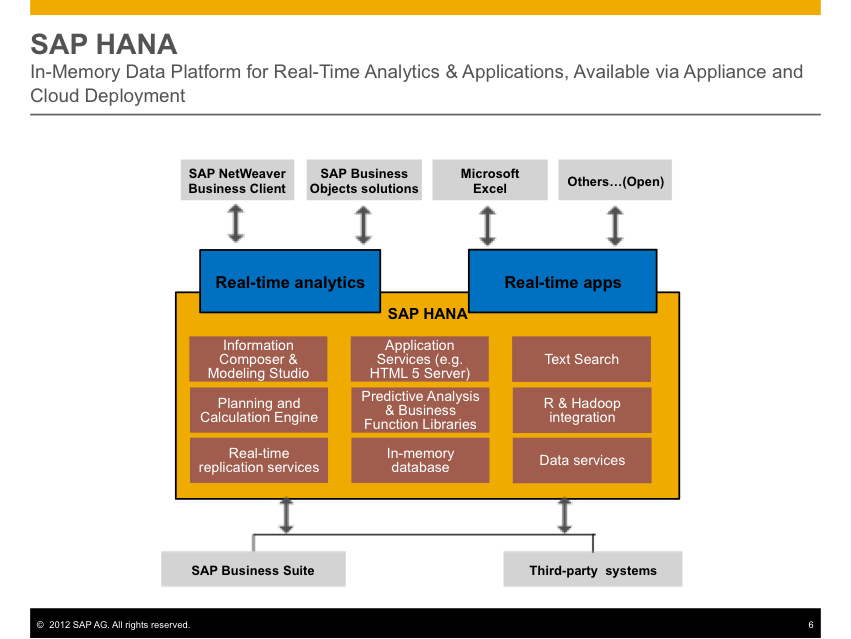
Source:archive.sap.com
The various unbelievable features and benefits of SAP HANA hold your interest to use the SAP HANA in your organization and businesses.
1. In-memory database: Previously the data were stored on a disk storage mechanism that is on a disk database management system, but with the help of in-memory database system, now it is possible to store the data completely in the main memory. It is much easy and quicker to work with data in-memory rather than extracting it from a file system, because of this feature nowadays the in-memory database systems are becoming more popular. The in-memory system plays a very vital role in the handling of the real-time-data future that involves new data types, for instance, social media monitoring and web automated sensors etc. With the help of SAP HANA the programmers are able to develop the applications that integrate business control logic more creatively at the database layer. The waiting time for data models are eliminated by using the SAP HANA, not only this it, also removes the time needed for loading the redundant data storage by old commercial depository solutions.
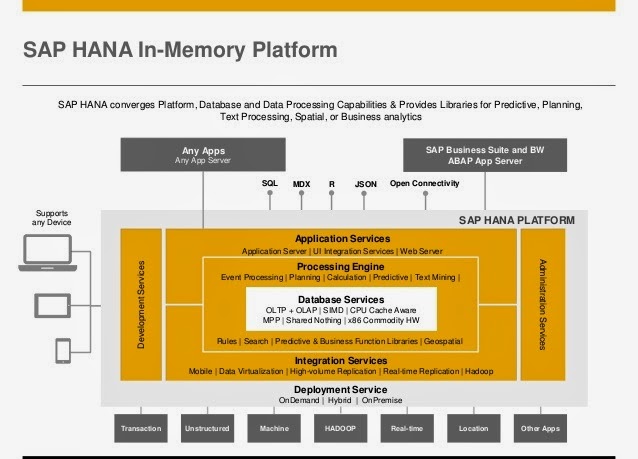
Source:www.saphanaclass.com
2. Real-time Analytics: In real-time data analytics the business warehouse i.e. BW phase required for generation of reports is eliminated. To perform the data analysis it uses the other available tools like BusinessObjectsExplorer or pivot tables in excel. The real-time, in-memory analytics has provided various benefits, it is possible to solve the problems, not in a day or hour, but in seconds,as it is easy and fast to make the decision based on real-time data. It provides smart and exact data in the fast-growing market scenarios. The various business operations are observed in a 360-degree view by combining and displaying data from different data sources. In SAP HANA the online analytical and transactional processing are combined into a single database system. The SAP HANA is proficient in collecting and apprising a large number of data sets in real-time. To understand this, let’s take an example of an insurance company, based on the real-time data the company is now able to determine, whether the south-areas are more profitable for its insurance policies or the central-areas with in a couple of seconds.
Learn SAP HANA from Industry Experts
3. Integrated Development Environment: SAP HANA provides an Integrated Development Environment i.e. IDE, which is a software application that offers a wide-spread service to the programmers and the software developers to carry out the software development task. An IDE generally includes a source code editor, build animation tools, a debugger and a GUI i.e. graphical user interface. The SAP HANA applications are developed and distributed in an easy and simple manner through the use of an IDE. The SAP HANA’s IDE is usually based on the eclipse based HANA studio and it enables various beneficial features such as integrated and cooperative development, server-side JavaScript to control, debugging, the arrangement of applications which are created on native database procedures for data handling, and an HTML 5 SDK for the user interface development. The entire design time objects of SAP HANA are deposited and handled in an SAP HANA repository.
4. The Columnar Data Storage: In the traditional databases, the data is usually stored in the form of a table that represents rows and columns. In its place, the SAP HANA has derived an exclusive feature of storing the data which is called columnar data storage. This unique feature lets the data or the computer memory to be structured in a linear way in contrast to the two-dimensional data structure which is usually structured in rows and columns. Therefore, in SAP the tables are demonstrated in one of the two ways, i.e. either in row-order or column-order. In row-order, the data in a table are stored as a set of records, while the entries in the adjacent memory locations are stored in a column-order. The Columnar data storage is a good approach as it allows run-length encoding, cluster coding, and dictionary coding, these methods are extremely proficient compression methods. The approach also removes the requirement for extra index structures because if the data is stored as a column it is similar to create a built-in index for each column. Once the extra indexes are eliminated, operations will be easier and simple, this eliminates the need for maintaining and defining metadata and quickens the speed of column scanning and also the read operations are carried out efficiently.
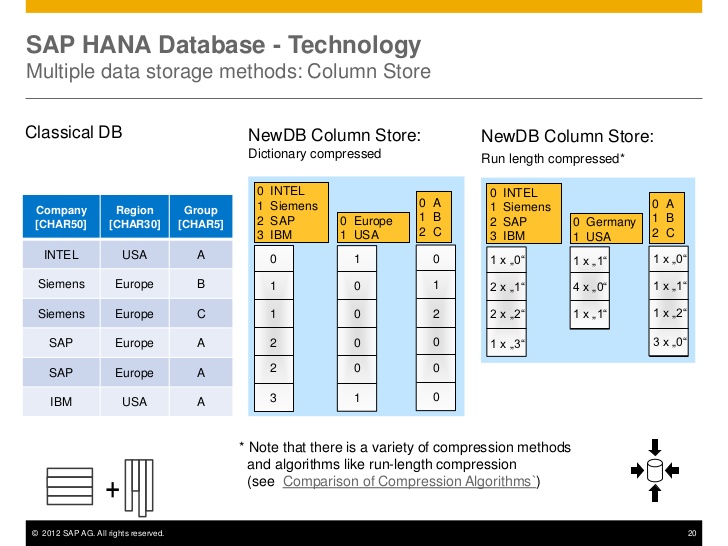
Source:www.slideshare.net
5. Parallel Processing: With the utilization of SAP HANA, it is possible to process multiple data as it supports parallel processing which is the center of the effective data analysis. SAP HANA supports for columnar data storage by utilizing which it is possible to carry out various operations in loops on an array in the contiguous memory location such as searching for a particular record, combining the data, etc. As compared to this approach in out-dated row-oriented approach, these kind of operations are very slow because the data which fits in the similar column is spread throughout the memory. But in column-based storage approach, this is done more quickly as it promotes the fast loading of data in the cache memory. Parallel processing of data is also possible with this approach as the data is divided vertically in column-based approach, by using the multiple processing centers. It is also conceivable to search and combine more than one column with parallel processing. The column is divided into different parts in order to speed up the process, and to carry out the operations in parallel on one column, each of these columns is processed by various processor cores.
6. SAP HANA Innovations: The numerous SAP HANA designers have made important innovations in IT as well as in the business. Due to the in-memory approach of SAP HANA, it is possible to bring out both hardware and software innovations which are uncommon. At the Software side, the SAP HANA simplifies the columnar data storage, partitioning, compression, and removal of combining of tables. On the other hand, at the hardware side, SAP HANA enables the Multi-core architecture, a vast parallel scaling with various edges, 64-bit address space, data throughput as high as 100 GB’s, cost-effectiveness, etc. The SAP HANA database can be integrated to the SAP ERP applications in the form of a secondary database. The existing databases can be moved to the SAP HANA database with the help of SAP NetWeaver Business Warehouse component, which is also called as a business data warehouse solution. Not only this, but there are infinite innovations which are possible with SAP HANA.
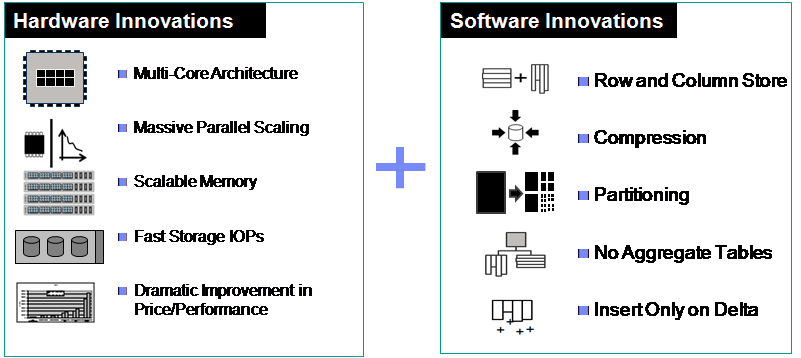
Source:blog.lenovo.com
7. SAP HANA Appliance Software: SAP HANA appliance software is flexible, adaptable, and an in-memory application that is proficiently combined with SAP software components, enhanced with the hardware provided and offered by the well-known SAP technology partners like HP, IBM, Fujitsu, Dell, and Cisco. The software includes various integrated SAP software components, such as the SAP HANA studio, which is an easy to use data modeling and administration tool, the SAP HANA database, and support for several interfaces based on industry standards. It can be associated with your structure to speed up the data warehousing and operational reporting without disturbing the current IT structure. SAP HANA is capable of managing the current Big data, computing speed, potential in information and extra data aggregation in data markets.
8. Improving current SAP application: In order to increase the performance of the hardware, the older database management systems worked on the restricted main memory. Their main aim is to emphasis on the disk access and to reduce the number of disk pages, which is to be read into the main memory at the processing time. Whereas SAP HANA works especially on memory adequately. Thus, instead of enhancing the input-output disk access, SAP HANA concentrate on improving the memory access amidst the CPU and main memory. There is a huge scope of developing the future in transactional applications as well as in the in-memory analytics. Also, it is possible to execute the current SAP application by utilizing open SQL on SAP HANA without any change. This helps in enhancing the existing SAP applications using SAP HANA.
9. Working on Aggregates Proficiently: The older databases and applications are using materialized aggregated rapidly to improve their performances. These aggregates are functioning and stored in the pre-decided times or when a write operation is carried out every time on the aggregated data. In place of computing the materialized combinations every time, these are considered as a read by read operations. Apart from this, it is also possible to compute the aggregates on a large amount of data effectively and efficiently because of its scanning speed of various gigabytes per milliseconds, due to this technique the requirements for materialized aggregates are also eliminated in certain cases.
Register for Live webinar on SAP HANA by Industry Experts
Conclusion:
Thus, by utilizing various features of SAP HANA such as robust computation power with built-in multitenancy, flexible modeling, large memory footprint, no data duplication and no aggregate tables, real-time analytics, the huge volume of data can be accessed in a single database and in one environment. The various applications of this can be seen in various businesses such as real state if it is required to access quickly the database to follow-up with clients, in an insurance company if they want to perform the calculation of the amount on various policies, or in a hospital if it is required to access the data of specific surgeries which are conducted previously. With the help of this data, it is easy to make the quick and efficient decision. These available features hold the interest of anyone and allow them to make the utilization of SAP HANA efficiently.
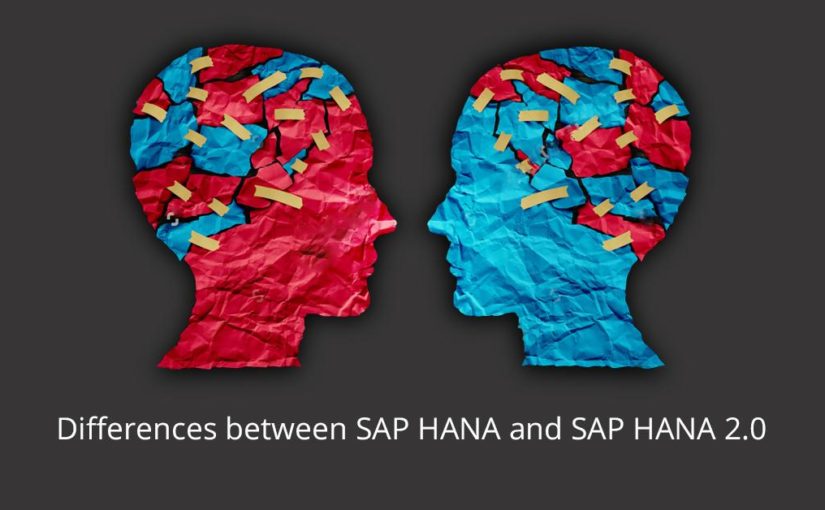

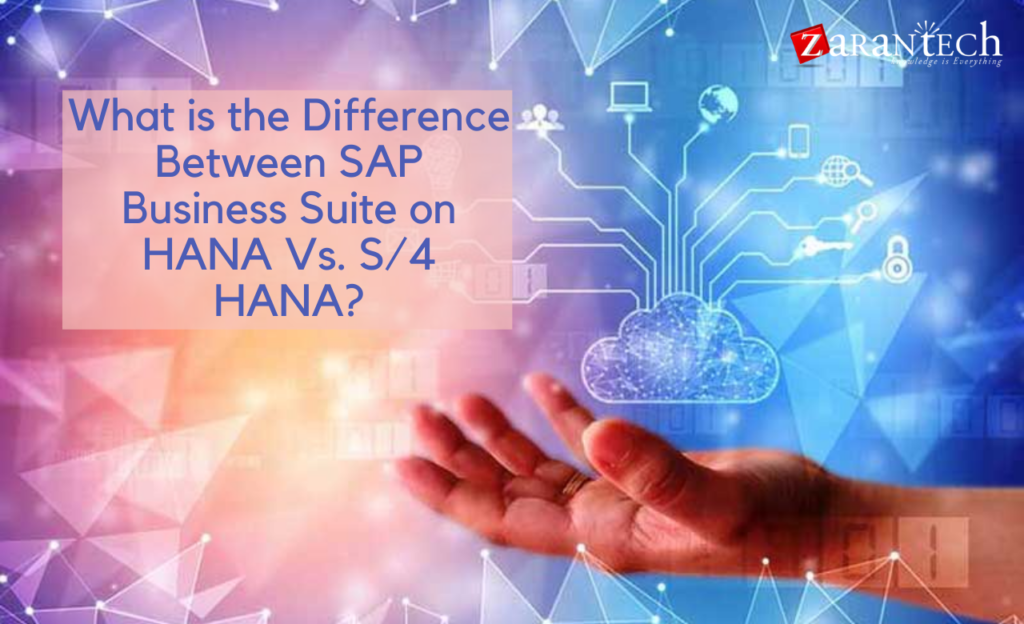

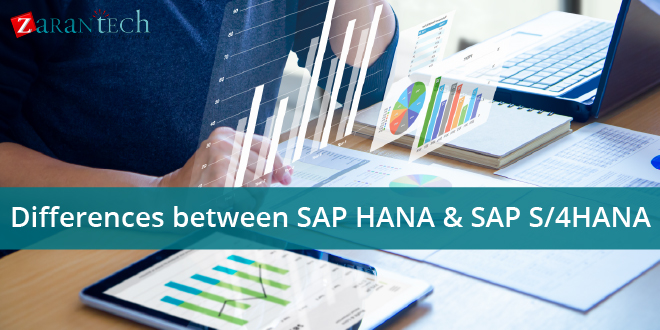
 99999999 (Toll Free)
99999999 (Toll Free)  +91 9999999
+91 9999999